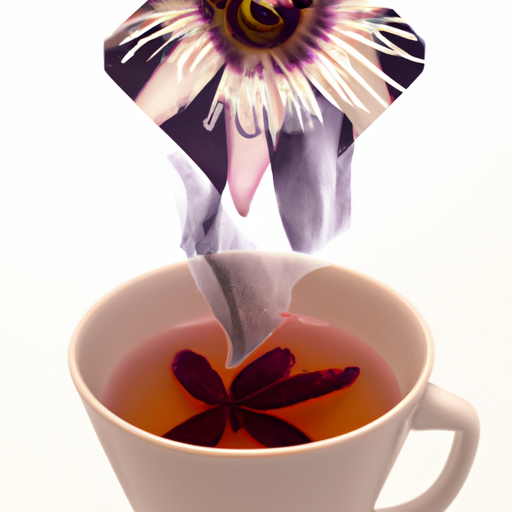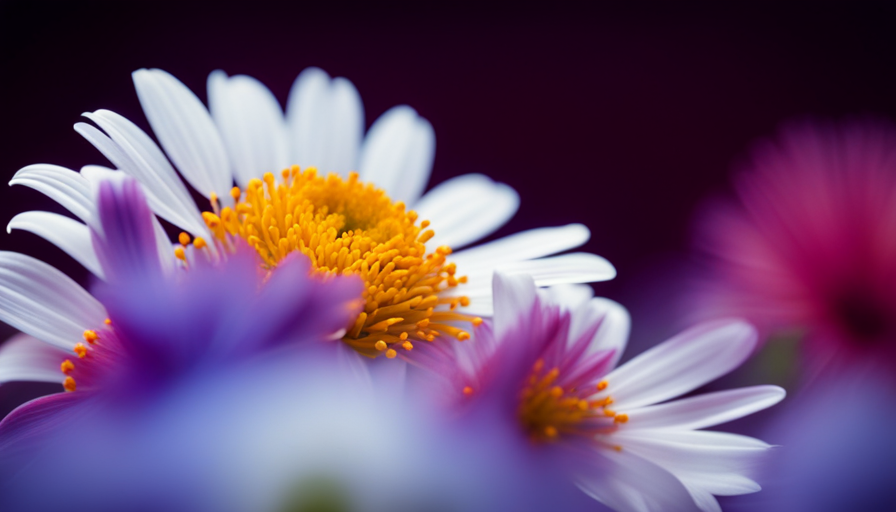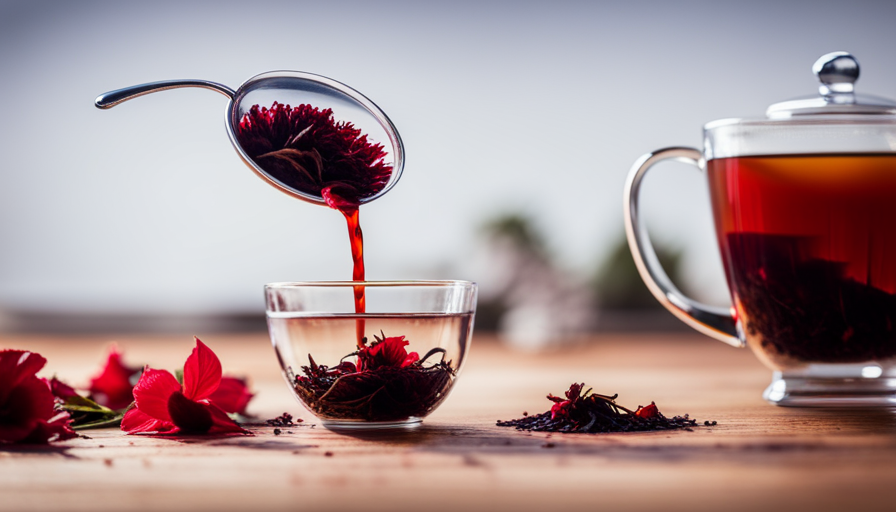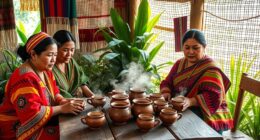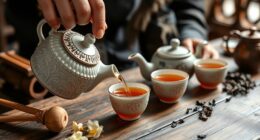In a world where stress and chaos seem to reign supreme, sometimes all we need is a soothing cup of tea to restore our sense of calm. Enter the enchanting organic whole calendula flower tea, a truly magical elixir that promises to transport you to a state of tranquility.
Picture yourself immersed in a serene garden, surrounded by vibrant orange petals dancing in the gentle breeze. As the warm water cascades over these delicate flowers, it extracts their healing properties, resulting in a brew that is both invigorating and calming.
In this article, I will guide you through the precise steps to create your own cup of this exquisite tea. From gathering the finest organic whole calendula flowers to experimenting with different brewing techniques, you will embark on a journey of sensory delight.
So, sit back, relax, and prepare to discover the art of brewing organic whole calendula flower tea.
Key Takeaways
- Choose fully open flowers free from blemishes or discoloration for the highest concentration of beneficial compounds.
- Prepare tea equipment by rinsing the teapot with warm water and bringing filtered water to a temperature of 200°F (93°C).
- Add a generous amount of dried calendula flowers to the teapot and stir gently to distribute them evenly.
- Strain the tea using a fine mesh strainer or tea infuser to remove the flowers.
Understand the Benefits of Calendula Flower Tea
Let’s explore the amazing benefits of sipping on some organic whole calendula flower tea! Calendula flower tea has been used for centuries due to its numerous health benefits. To fully appreciate this herbal beverage, it’s important to learn about its rich history.
Calendula, also known as marigold, has been revered for its medicinal properties since ancient times. People’ve long recognized its ability to soothe inflammation, heal wounds, and alleviate digestive issues. In addition to its healing properties, calendula flower tea is also known for its high levels of antioxidants, which help to protect the body against cell damage and promote overall well-being.
While there are many potential benefits to drinking calendula flower tea, it’s important to be aware of any potential side effects. Some individuals may experience allergic reactions, such as skin rash or irritation, when consuming calendula flower tea. It’s always recommended to consult with a healthcare professional before incorporating any new herbal tea into your routine.
Now that we’ve explored the benefits and potential side effects of calendula flower tea, let’s move on to the next step: gathering organic whole calendula flowers.
Gather Organic Whole Calendula Flowers
First, you’ll need to source the key ingredient – those vibrant, sun-kissed petals that hold a world of wellness within them. To ensure the highest quality, I recommend gathering organic whole calendula flowers. Here’s how to do it:
-
Choose the right time: Harvest the flowers on a dry and sunny morning when the dew has evaporated. This ensures that the flowers are at their peak potency.
-
Select healthy flowers: Look for flowers that are fully open and free from blemishes or discoloration. These flowers contain the highest concentration of beneficial compounds.
-
Use clean harvesting tools: Sterilize your scissors or garden shears to prevent any contamination. This ensures that your flowers remain pure and free from any harmful substances.
-
Harvest with care: Gently snip off the flower heads, leaving a bit of the stem intact. This allows the plant to regenerate and produce more flowers in the future.
Once you have gathered your organic whole calendula flowers, you’re ready to move on to the next step of preparing your tea equipment. But before we do that, let’s explore the health benefits of calendula and some delicious calendula flower recipes.
Prepare Your Tea Equipment
Get your tea set ready and feel the anticipation build as you prepare to steep the vibrant essence of wellness into your favorite cup. Choosing the right tea leaves is crucial in making the perfect organic whole calendula flower tea. Look for dried calendula flowers that are whole and vibrant in color, as they contain the highest concentration of beneficial compounds. Avoid wilted or discolored flowers, as they may not provide the desired flavor and health benefits.
Once you’ve selected your organic whole calendula flowers, it’s important to prepare your tea equipment properly. Start by rinsing your teapot with warm water to remove any impurities. Then, fill your kettle with fresh, filtered water and bring it to a temperature of around 200°F (93°C). This temperature is ideal for extracting the delicate flavors and beneficial properties of the calendula flowers.
Pour the hot water into your teapot, allowing the steam to rise and warm the teapot. Add a generous amount of dried calendula flowers to the teapot, approximately one tablespoon per cup of water. Gently stir the flowers with a wooden spoon to distribute them evenly.
In the next section, we’ll discuss how to measure and rinse the calendula flowers, ensuring that they’re clean and ready to be steeped in the hot water.
Measure and Rinse the Calendula Flowers
Once you’ve chosen the perfect vibrant blooms, carefully measure out the blossoms and give them a gentle rinse. Make sure they are pristine and ready to infuse their healing essence into your cup. Calendula flower tea isn’t just delicious, it also offers numerous health benefits.
By following these steps, you can create a flavorful and beneficial tea that’ll leave you feeling refreshed and rejuvenated.
To prepare your calendula flowers, you’ll need the following items:
-
A dry measuring cup: This’ll ensure you use the correct amount of flowers for your tea.
-
A fine-mesh strainer: This’ll help remove any impurities or debris from the flowers.
-
A colander or sieve: This’ll be used to rinse the flowers under cool water.
-
A clean towel or paper towels: These’ll be used to gently pat dry the flowers after rinsing.
Using dried calendula flowers in your tea is a great way to enjoy their benefits. Calendula flowers are known for their anti-inflammatory properties and can help soothe digestive issues and promote healthy skin. By incorporating these dried flowers into your tea, you can harness their healing properties and reap the rewards.
To continue with the process, you’ll need to boil water and steep the calendula flowers.
Boil Water and Steep the Calendula Flowers
Now, all you have to do is bring that water to a boil and let those beautiful calendula flowers steep, releasing their soothing and rejuvenating essence that will leave you feeling refreshed and revitalized. Calendula flower tea offers numerous benefits when consumed as an herbal tea. Herbal teas, also known as tisanes, are popular for their various health benefits and can be made from a variety of plants, each with its own unique properties.
To make the perfect cup of organic whole calendula flower tea, follow these simple steps:
- Measure and rinse the calendula flowers as mentioned in the previous section.
- In a clean pot, bring water to a boil. Use filtered water for the best taste.
- Once the water boils, carefully add the rinsed calendula flowers to the pot. Use approximately 1 tablespoon of flowers for every cup of water.
- Reduce the heat to low and let the flowers steep for 10-15 minutes. This allows the beneficial compounds to infuse into the water.
- After steeping, strain the tea using a fine mesh strainer or a tea infuser to remove the flowers.
- Pour the hot tea into your favorite cup and enjoy the soothing aroma and taste.
Drinking herbal teas regularly can provide a range of health benefits, such as promoting relaxation, boosting the immune system, and aiding digestion. Now, let’s move on to the next section about adding sweeteners or enhancements (optional) to further customize your cup of organic whole calendula flower tea.
Add Sweeteners or Enhancements (Optional)
After boiling the water and steeping the calendula flowers, it’s time to add some sweeteners or enhancements to your organic whole calendula flower tea. This step’s optional, but it can elevate the flavor profile and make your tea even more enjoyable.
There are various sweetener options and flavor combinations to choose from, allowing you to customize your tea to suit your preferences. Here are some suggestions to consider:
- Honey: A natural sweetener that adds a subtle floral note to the tea.
- Lemon: Squeezing a fresh lemon into your tea can provide a tangy and refreshing taste.
- Mint leaves: Adding a few crushed mint leaves will give your tea a cool and invigorating flavor.
- Ginger: Grating some fresh ginger into the tea can add a spicy and warming element.
- Cinnamon: Sprinkling a pinch of cinnamon powder will infuse your tea with a warm and comforting aroma.
These additions can enhance the already delicate and earthy flavor of the calendula flowers, creating a truly delightful tea experience.
Now that your tea’s infused with your chosen sweetener or enhancement, it’s time to savor the unique blend of flavors and enjoy your organic whole calendula flower tea.
Enjoy Your Organic Whole Calendula Flower Tea
Indulge in the delightful blend of flavors and savor the soothing experience of enjoying your fragrant cup of golden goodness. Organic whole calendula flower tea not only offers a tantalizing taste but also provides numerous health benefits.
This herbal infusion is known for its anti-inflammatory properties, which can help alleviate digestive issues and soothe sore throats. Moreover, the tea contains antioxidants that can boost your immune system and promote healthy skin.
To enhance the taste and reap additional benefits, you can experiment with various recipes incorporating organic whole calendula flowers. For a refreshing twist, try adding a squeeze of lemon or a sprig of mint. If you prefer a sweeter flavor, consider infusing the tea with a touch of honey or a sprinkle of cinnamon. These additions not only enhance the taste but also provide their own unique health benefits.
As you enjoy your cup of organic whole calendula flower tea, take a moment to appreciate the natural beauty and therapeutic properties of these vibrant blossoms.
To ensure the longevity and freshness of your remaining calendula flowers, store them properly in an airtight container away from direct sunlight. This will preserve their flavor and potency for future use.
Store the Remaining Calendula Flowers Properly
To keep your remaining calendula flowers fresh and preserve their vibrant colors, it’s important to store them properly. Store them in an airtight container away from direct sunlight. Properly storing calendula flowers is crucial to preserving their freshness and maximizing their potential health benefits.
When exposed to sunlight, the flowers may lose their color and become less potent. Therefore, it’s recommended to store them in a cool, dark place, such as a pantry or cupboard.
To ensure the flowers stay fresh, it’s important to remove any moisture or humidity from the storage container. You can achieve this by adding a moisture-absorbing packet or using a vacuum-sealed container. Additionally, make sure the container is airtight to prevent any air from entering and causing the flowers to deteriorate.
Preserving the freshness of calendula flowers also involves avoiding contact with moisture or any other substances that could lead to mold or decay. It’s advisable to separate the flowers from any stems or leaves before storing them, as these parts tend to spoil faster.
By properly storing your calendula flowers, you can extend their shelf life and maintain their vibrant color and aroma. Now that you know how to store them, let’s move on to the next section and experiment with different brewing techniques to make the perfect cup of organic whole calendula flower tea.
Experiment with Different Brewing Techniques
Let’s explore various methods to brew your calendula flowers and unlock a world of aromatic and flavorful possibilities. Brewing the perfect cup of organic whole calendula flower tea requires careful attention to the brewing temperature and steeping time. By experimenting with different techniques, you can discover your preferred method for extracting the maximum flavor and benefits from these beautiful flowers.
To ensure the best results, it is crucial to consider the brewing temperature. Calendula flowers are delicate and sensitive to heat, so a temperature range of 180-200°F (82-93°C) is recommended. Higher temperatures may result in a bitter taste, while lower temperatures may not extract enough flavor. Finding the right balance is key to creating a delicious and soothing cup of tea.
In addition to the brewing temperature, steeping time can also vary depending on personal preference. For a lighter and more delicate flavor, steep the flowers for 3-5 minutes. If you prefer a stronger and more robust taste, extend the steeping time to 7-10 minutes. Experimenting with different steeping times allows you to customize your tea to your liking.
By understanding the importance of brewing temperature and steeping time variations, you can elevate your calendula flower tea experience. In the next section, we will explore other exciting uses for calendula flowers and how they can enhance your daily life.
Explore Other Uses for Calendula Flowers
After experimenting with different brewing techniques for my organic whole calendula flower tea, I decided to delve deeper into the world of calendula flowers and explore their other uses. Calendula flowers aren’t just known for their beautiful appearance and soothing properties, but they also have a wide range of other medicinal uses and culinary applications.
Here are some fascinating ways you can incorporate calendula flowers into your daily life:
-
Medicinal uses: Calendula flowers have traditionally been used to treat various skin conditions such as cuts, burns, and rashes due to their anti-inflammatory and antimicrobial properties. They can also be used to make healing salves, creams, or infused oils for topical application.
-
Culinary applications: Calendula flowers have a slightly bitter and peppery taste, making them a unique addition to salads, soups, or stir-fries. You can also use them to infuse oils, vinegar, or even make calendula tea for a refreshing and healthful beverage.
-
Natural dyes: Calendula flowers can be used to create vibrant natural dyes for fabrics, yarns, or even Easter eggs. By simmering the flowers in water, you can extract their vibrant yellow and orange pigments.
-
Companion planting: Calendula flowers attract beneficial insects such as bees and butterflies, making them excellent companion plants in your garden. They can help deter pests and promote pollination.
-
Herbal remedies: Calendula flowers can be used to make herbal remedies such as tinctures, extracts, or herbal teas. They’re believed to have anti-inflammatory, antifungal, and immune-boosting properties.
Exploring the various uses of calendula flowers not only adds versatility to your herbal repertoire but also lets you fully appreciate the wide range of benefits these beautiful flowers offer.
Frequently Asked Questions
Where can I find organic whole calendula flowers?
Finding organic suppliers for whole calendula flowers can be a challenge, but it’s worth the effort. Organic flowers are free from harmful pesticides and chemicals, ensuring a pure and natural product.
I recommend searching online for reputable organic herb suppliers or visiting local farmers markets. Using organic flowers in your tea not only enhances the flavor, but also preserves the beneficial compounds and nutrients that can support your overall well-being.
How long does it take for the calendula flowers to steep in boiling water?
To determine the right steeping time for different types of herbal teas, it’s important to consider the specific characteristics of each herb. For calendula flower tea, I recommend steeping the flowers in boiling water for approximately 5-10 minutes. This allows the water to extract the beneficial compounds without oversteeping and resulting in a bitter taste. To enhance the flavor of calendula flower tea, you can add a touch of honey or a squeeze of lemon juice.
Can I use dried calendula flowers instead of fresh ones?
Yes, you can use dried calendula flowers instead of fresh ones to make tea. However, it’s important to note that using fresh calendula flowers has several benefits. Fresh flowers contain higher levels of volatile oils, antioxidants, and other bioactive compounds, which may enhance the tea’s medicinal properties.
Dried flowers, on the other hand, have a longer shelf life and are more convenient to store and use. So, while dried flowers are a viable option, fresh flowers offer additional health benefits.
Are there any potential side effects or precautions to be aware of when drinking calendula flower tea?
When it comes to drinking calendula flower tea, I must caution you about the potential side effects and precautions. While this tea offers potential health benefits such as anti-inflammatory and antioxidant properties, it’s important to consume it in moderation. Excessive intake may lead to stomach irritation or allergic reactions. It’s recommended to limit your dosage to 2-3 cups per day and consult with a healthcare professional if you have any underlying health conditions or are taking medications.
Can I use calendula flower tea for skincare purposes?
Yes, you can definitely use calendula flower tea for skincare purposes. Calendula flower tea has numerous benefits for the skin. It’s known for its anti-inflammatory, antioxidant, and antimicrobial properties. It can help soothe irritated skin, reduce redness, and promote healing.
There are several DIY skincare recipes with calendula tea, such as face masks, toners, and creams that can be easily made at home to enhance your skincare routine.
Conclusion
In conclusion, making organic whole calendula flower tea is a simple and rewarding process. By understanding the benefits of calendula flower tea and gathering high-quality organic flowers, you can enjoy a delicious and soothing beverage.
Remember to properly measure and rinse the flowers, and steep them in boiling water for maximum flavor and health benefits. Don’t forget to experiment with different brewing techniques to find your perfect cup of tea.
And don’t stop at just tea – calendula flowers have a multitude of other uses to explore. So start brewing and discover the wonders of calendula flower tea today!



